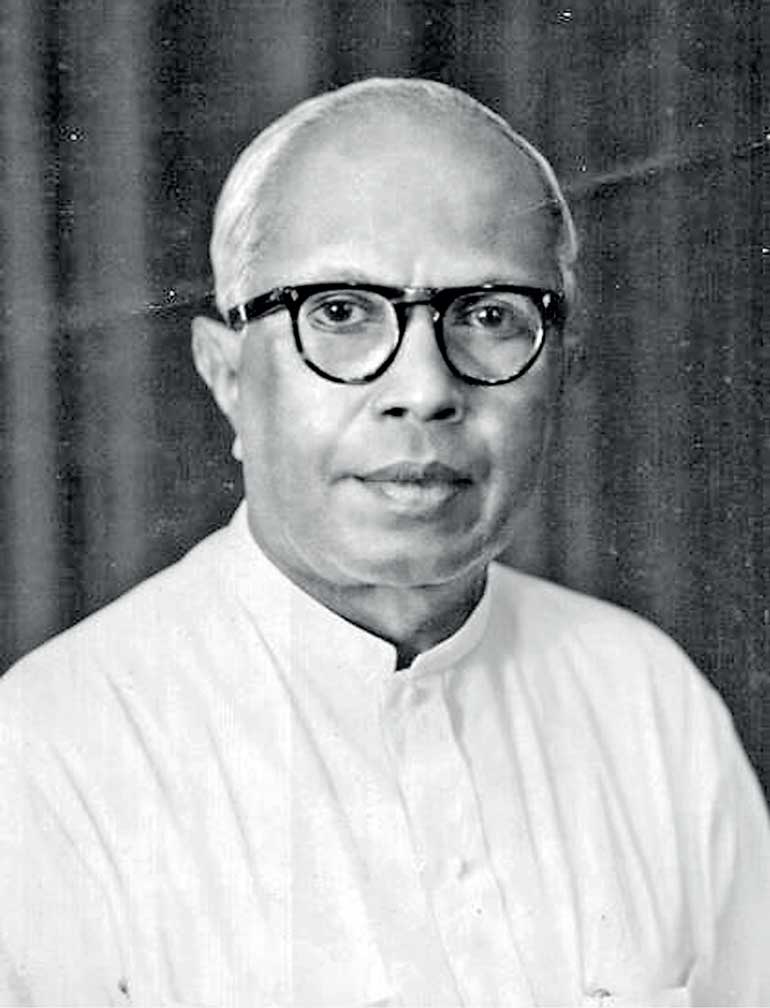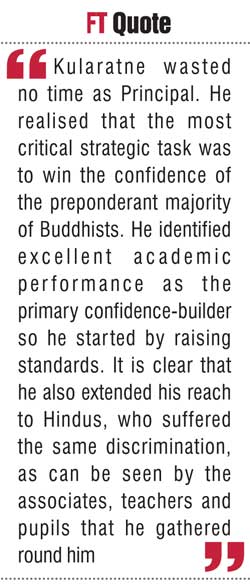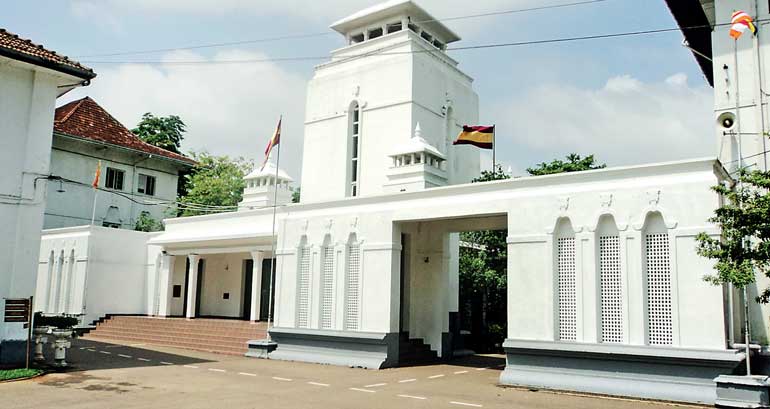Friday Jan 31, 2025
Friday Jan 31, 2025
Monday, 1 January 2018 00:00 - - {{hitsCtrl.values.hits}}
100 years ago, on 1 January 1918, an unknown young man was appointed as Principal of Ananda College. Patrick de Silva Kularatne, barely 25 years old, had just graduated from the University of London and had no working experience whatsoever. He was charged with accelerating the development of Ananda, to create a model institution in order to spearhead the education of the common man. This must have seemed wildly ambitious in the colonial environment of the day and nobody other than the Principal and the school’s manager, W.A. de Silva, were optimistic… initially.

Patrick de Silva Kularatne
Although Ananda was the premier non-Christian missionary college at the time, it had less than 400 regular students and 15 or so teachers after 31 years of existence. Despite the collective efforts of its founders and illustrious past principals Ananda was finding it difficult to make significant headway. Opposition and discrimination by the missionary establishment in league with the British government were coordinated and unrelenting. The Buddhist organisations were somewhat disorganised and always short of funds. And worst of all, apathy and low self-esteem among the Buddhist public led them to enrol their children in tried and tested missionary schools with much better facilities developed over many years. All the major schools had non-Ceylonese as their heads.
To complicate matters further, World War II was still raging, the economy had slowed down and the colonial administration was on edge. During the so-called Sinhala-Muslim riots of 1915, and the violent 100 days of martial law that followed, Ananda College had been unfairly suspected of fomenting unrest. A few years earlier Ananda had been a meeting venue for nationalist groups and the Temperance Movement, which the Government saw as political, directing an assault on their considerable excise revenues.
Many prominent Buddhists were jailed during the 1915 riots without any evidence, but paradoxically, all this caused the Sinhala Christians and Tamil Hindus to come out in defence of the rights of their fellow countrymen, and drew them all into one national group. The pre-cursor of the Ceylon National Congress was formed in 1917 with Sir Ponnambalam Arunachalam as president.
Ananda was originally established to provide Buddhist children with a modern education in a Buddhist environment and to overcome the disadvantages they faced in society. However, by 1918 the demand for independence was gathering strength and so was the appreciation of the crucial role that educational institutions play in nation building. Ananda was clearly intended to be a pivotal organisation in the transition of the country to independence. Young Kularatne took over at Ananda in turbulent times.
Background
Kularatne was an outsider in Ceylon’s high society of the day. Born in Ambalangoda to a middle-class family, he was educated at local schools and then at Richmond College, Galle. He was a brilliant student from his early days and carried away most of the prizes at Richmond including one for Christianity. He even became the Head Prefect despite not being a Christian. Mathematics was his forte and he had a life-long interest in the subject. He won one of the two annual government scholarships then available for higher studies and left for London in 1913. However, the most lasting lesson he learnt at Richmond was the importance of commitment and service.

He later wrote: “The best education one can give a child is the opportunity to associate with good people. To be in touch for some time with one of them is an education in itself. I value highly the associations I have had in my life with three good persons – first a good Buddhist, second a good Christian and last a good Positivist. I am grateful to the Christian Mission in Ceylon not for the gift to us of English education but for the many opportunities they have given to the young men and women of Ceylon to associate with good men and women whose lives were splendid examples of service and sacrifice.”
Within a matter of four years at the University of London he obtained three degrees including a first-class BA in Mathematics and another first-class BSc. In parallel he had enrolled to study Law, and in 1917 obtained a second-class LL.B degree and was called to the Bar just before he sailed for Ceylon.
Perhaps because of his stunning academic achievements, his relative youth and inexperience do not seem to have daunted him at all when he took on the challenging job at Ananda. He was probably heartened by the fact that his revered Principal at Richmond College, Rev. Small, had been just 23 years old when he had taken over.
Starting work
Kularatne wasted no time as Principal. He realised that the most critical strategic task was to win the confidence of the preponderant majority of Buddhists. He identified excellent academic performance as the primary confidence-builder so he started by raising standards. It is clear that he also extended his reach to Hindus, who suffered the same discrimination, as can be seen by the associates, teachers and pupilsthat he gathered round him.
He convinced his staff to contribute part of their meagre salaries into a scholarship fund, and W.A. de Silva doubled it, enabling three scholarships to be offered. Candidates had to pass a rigorous written test and the ones who succeeded produced stunning results when they sat the Cambridge Senior exam. That started a chain reaction and within a year or two there was a clamour to enter Ananda.
There were very few well-educated and trained local teachers willing to join Ananda at the start, so Kularatne hired the best he could find from overseas through the network of the BTS. They did not come for the remuneration, which was relatively meagre, but because they were passionate about the cause. Before long the college developed a highly professional and committed staff and was able to attract students from other more established schools in the country.
Finding money
In 1918 itself, Kularatne had convinced the school’s managers, the Buddhist Theosophical Society (BTS), to let him handle the financial management. This allowed him the flexibility and freedom to use numerous unconventional methods to raise funds for the insatiable appetite for infrastructure and teachers. The modest government grant was totally inadequate, and funding Ananda’s meteoric rise remained a challenge throughout his tenure.
There were a few large benefactors but the less affluent sections also contributed. Many innovations were introduced such as the ‘one-cent fund’. Teachers and boys fanned out all over Colombo and collected donations from any willing source – ‘vattiammas’, rickshaw pullers, petty traders and daily wage earners – who gladly donated their mite towards Ananda. There were many country-wide multi-day fundraising campaigns too.
Ananda was making visible progress and there was a sense of reverence now in the people’s attitude towards the school. It was considered almost a national duty to assist Ananda. These campaigns also helped to take the message of Ananda across the length and breadth of the country.
Kularatne also introduced the most effective and successful method of fund raising, the school fun-fair (carnival). The Golden Jubilee fun-fair in 1936 was the first ever for a school and raised sufficient money to pay back most of the school’s debts.
Infrastructure
Kularatne had an instinctive feel for assessing, costing and marketing the school’s projects be they classrooms, laboratories, libraries, hostels or sports facilities. Between 1918 and 1925, the first seven years of the Kularatne era, the floor area was tripled from the initial 20,000 sq. ft. to about 60,000 sq. ft. and student numbers rose to 1,400. This included Nalanda Vidyalaya, which he started as an extension of Ananda in 1923 and made a separate school in 1925.
Creating the right environment
Kularatne’s vision of Ananda was broad and not restricted to academic education, or to Ananda College itself. He wanted to inject social and cultural dimensionsso that Ananda would become a role model to lead the way to the rapid growth of similar institutions throughout the country. Whilst he was Principal of Ananda he was actively involved in establishing, assisting or managing scores of other BTS schools, which grew from 250 to 420 during his time in office. Kularatne also moved to Kandy as Principal of Dharmaraja College between 1932 and 1936 to help it recover from serious financial difficulties.
Tarzie Vittachi, a student of Kularatne and a renowned journalist and writer, later wrote:
“I thought then, as I do now, that Ananda, for him, was a proving ground for his vision of a free Lanka, a united, mentally and physically educated country whose way of life would be modulated by the broad-mindedness of the Buddha and inspired by his rejection of superstition as an explanation of reality. His horizons were far beyond Maradana Road and Kuppiyawatta.”
Despite objections from conservative Buddhists, English classes for Buddhist monks commenced in 1919 and they in turn taught Pali, Sanskrit and Buddhism to the students. Some joined the staff as residential teachers.
In the early 1920s he started editing a weekly magazine in English named ‘The Buddhist Chronicle’, which tackled controversial and topical matters and provided a forum for various views to be aired and discussed. The school curriculum was widened to include deeper study of Pali and Sanskrit as well as local languages and literature. He and Malalasekera ensured that Paliand Sanskrit were added to the Cambridge Senior examination. Sinhala drama, music, literature and folk arts were actively encouraged both inside and outside Ananda.
Kularatne soon realised that some parents found his Western dress intimidating, so he and his Vice Principal, G.P. Malalasekera, discarded their British suits and started wearing what is now called the national dress.
Teachers were encouraged to write text books with local content where necessary such as in geography and history and the much-neglected subject of Ceylon History was introduced. When the medium of education was gradually being changed to Sinhala, teachers of Ananda were in the vanguard. Kularatne himself wrote a series of books on mathematics that were used by other schools too.
Ananda continued its tradition of being at the forefront of national affairs and the college hall hosted meetings of the Ceylon National Congress and the All Ceylon Buddhist Congress. In addition, eminent Indians of the period, such as Rabindranath Tagore, Mahatma Gandhi, Sarojini Naidu and Jawaharlal Nehru visited the school.
However, Ananda was not a narrowly focused ‘Sinhala-Buddhist’ institution. In 1923 Ananda was the only school where Sinhala, Tamil and Pali were all taught. Kularatne believed that Sinhala and Tamil should be taught in all secondary schools and, at Ananda, there were active Tamil literary and cultural societies run by Tamil students from the 1920s to the 1940s.
When in 1921 T.B. Jayah, then a senior teacher at Ananda, was asked by the managers of Zahira College, Colombo to take over and revive it, Kularatne not only encouraged Jayah but even seconded some of his own teachers to assist him. Jayah was Principal of Zahira for 27 years and the two were close associates.
The well-known political leader and economist, Dr. N.M. Perera, recalled his impressions on moving from St. Thomas’ College to Ananda in the 1920s: “Herein lays the great divide. Missionary education was both a political and anti-national, not specifically, but insidiously so. An institution like Ananda had a different tone and a different atmosphere. At Ananda, one felt the impact of everything that was happening in the country, to the people of the country. At an institution like St. Thomas’ one felt aloof and immune from the hurly burly of everyday life. I believe this was typical of most missionary schools that functioned during this time. In this new atmosphere charged with nationalist feelings, the more serious side of my character was being stirred. Ananda was slowly remoulding me. Every discussion, every controversy was stirring something latent in my consciousness.”
When in 1943 Kularatne retired at the age of 50 years, T.B. Jayah had this to say: “A grateful public cannot forget the pioneers of Buddhist education who had to contend against powerful forces backed at times even by the Government itself, and who had prepared the ground for those who followed them. Mr. Kularatne himself will be the first to acknowledge his immense debt to them, but it will be generally admitted that it was the advent of Mr. P. de S. Kularatne as principal of Ananda that heralded the dawn of a new era in Buddhist Education in Ceylon.
“The Education Code, Departmental Circulars, opposition from vested interests – these had no terrors for him. His bitterest opponents – some of them were found even among his co-workers – have been constrained to admit that he has succeeded where others may have failed.
What is the secret of his success as Principal of Ananda? Did he merely confine himself to teaching and administering the college? Did he always depend on the Governing body of the college for the successful carrying out of his schemes? Did he look on with folded arms till buildings were put up or money found by the college authorities to meet the growing needs of the college? Did he cut himself off from the public life of the country and dedicate himself to educational work as indicated in the school time table?
“If he had simply done this and nothing more, Ananda College would not be what it is today, the radiating centre of Buddhist educational thought and activity; Buddhist education would not be so widespread and so powerfully organised; Mr. Kularatne himself would not be occupying a leading position among the educationists of the Island nor even become a member of the State Council.”
And veteran journalist D.B. Dhanapala, in his book ‘Among Those Present’ about leading personalities of the pre-independence period, comments: “Kularatne was perhaps the greatest man we have produced in modern times. He was not only a great teacher, he was also a great maker of men, builder of many schools, usherer of a revival, inspirer of a new outlook. If greatness is to be measured by the yardstick of influence exerted on the generation a man lives in, Kularatne has made his contribution more than any other single individual of our time.”

Ananda College Colombo
(For more detailed accounts see: “ANANDAYA – the first 125 years of Ananda College” (available at the OBA office in Ananda College) and “Kularatne of Ananda – by Kamalika Peiris” (available at Sarasavi Bookshops and other booksellers).)